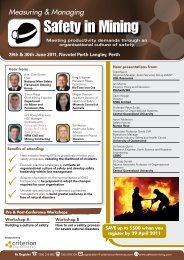Australia's junior explorers - The ASIA Miner
Australia's junior explorers - The ASIA Miner
Australia's junior explorers - The ASIA Miner
Create successful ePaper yourself
Turn your PDF publications into a flip-book with our unique Google optimized e-Paper software.
Secondary Crushing Circuit<br />
As part of a wider PIO study a secondary<br />
crushing circuit was surveyed while being<br />
fed with a particular ore type. To determine<br />
the origin of the or e at any particular time<br />
and, most importantly, during the surveys,<br />
SmartTag detection points were set up at<br />
three locations around the circuit. <strong>The</strong> three<br />
locations were primary crusher pr oduct,<br />
secondary crusher feed and secondary<br />
crusher product.<br />
A total of 384 mini RFID tags were placed on<br />
eight polygons (a polygon is defined as dif ferent<br />
ore zones within the mine block model)<br />
after the blast, the ROM pad and trucks as<br />
they tipped ore into the primary crusher.<br />
Of the 384 tags placed onto either the<br />
muck pile or on the ROM pad, 45% wer e<br />
detected. However, if this is compared with<br />
the percentage of each polygon that had<br />
been excavated by the end of the trial it is a<br />
fair conclusion that many of the RFID tags<br />
that weren’t detected were also not excavated<br />
during the trial.<br />
To determine the survival rate of the tags<br />
during secondary crushing, the number of<br />
tags detected before and after the secondary<br />
crusher wer e compared. Of the 128<br />
tags detected befor e the secondary<br />
crusher, 97 were also detected after secondary<br />
crushing.<br />
However, as there were 52 tags that were<br />
detected after the secondary crusher but<br />
weren’t detected befor e the secondary<br />
crusher, the real survival rate is dif ficult to<br />
determine. By just comparing RFID tags detected<br />
at both detection points, it can be<br />
concluded that at least 76% of the mini tags<br />
survived secondary crushing, although this<br />
number is likely to be much higher.<br />
<strong>The</strong> screen immediately following the secondary<br />
crusher uses panels with 55-mm<br />
apertures and, as expected, none of the<br />
tags were recycled back through the secondary<br />
crusher.<br />
<strong>The</strong> primary application for SmartTag was<br />
to determine the origin of the or e being<br />
processed during the plant surveys. In this<br />
application, where the plant feed included ore<br />
from ROM mixing and stockpiles, SmartT ag<br />
was essential for determining which materials<br />
were processed in the plant at the time of<br />
the surveys. Mini tags wer e required to enable<br />
the ore source to be tracked all the way<br />
through secondary crushing, and pr oved to<br />
be robust enough to survive both blasting<br />
and secondary crushing.<br />
HPGR Circuit<br />
PTI was contracted to assess<br />
the performance of a<br />
circuit at a mine in South<br />
America. <strong>The</strong> SmartT ag<br />
system was used in this<br />
application to allow PTI<br />
engineers to know exactly<br />
when a surveyed blast<br />
was being processed. For<br />
this reason, detection<br />
points were located on<br />
conveyor belts carrying<br />
the product of the primary<br />
crusher, the output of the<br />
stockpile and the HPGR<br />
(High Pressure Grinding<br />
Roll) feed.<br />
As the blast was being<br />
audited RFID tags wer e<br />
deposited into 68 blastholes,<br />
using an even split<br />
of 34 normal tags and 34<br />
mini tags. A further 50<br />
tags were later added<br />
into the trays of 25 trucks<br />
at the primary crusher ,<br />
using one of each of the<br />
two different types of<br />
tags in each truck.<br />
A total of 68 tags wer e<br />
identified at the primary<br />
crusher product detection<br />
point, 23 at the stockpile<br />
output detection point and<br />
41 at the HPGR feed detection point.<br />
<strong>The</strong> blast occurred January 22 and the excavation<br />
of the muck pile took place roughly<br />
two months later between March 15–17. <strong>The</strong><br />
SmartTag system monitor ed the material<br />
passing through the process over a period of<br />
30 hours. During this period, a total of 67 different<br />
tags were detected; 33 were of normal<br />
size and 34 were mini tags.<br />
For the stockpile and HPGR feed detection<br />
points, the recovery was calculated with reference<br />
to the 64 distinct RFID tags detected<br />
at the primary crusher. Of the normal tags detected<br />
at the primary crusher detection point,<br />
42.4% were then detected at the HPGR feed<br />
detection point; whereas for the mini tags<br />
67.6% of tags detected at the primary<br />
crusher were also detected at the HPGR<br />
feed. This shows that the survival of the mini<br />
tags in the circuit is higher than the normal<br />
tags. In a hypothetical situation, wher e the<br />
secondary screening mesh is smaller than 50<br />
Grinding Mills<br />
Eirich’s fine-grinding TowerMills have applications in a wide range of materials<br />
that include copper, zinc and lead ores, iron ore, slags, and others.<br />
x 50 mm, normal tags certainly would not<br />
reach the HPGR.<br />
<strong>The</strong> detection of tags at the primary crusher<br />
was also af fected by the r emoval of the<br />
SmartTag system before the entire blast was<br />
processed for logistical reasons.<br />
<strong>The</strong> tags were used to track the material during<br />
an optimization campaign at the plant. During<br />
the plant survey the material that fed the<br />
plant originated from the central portion of the<br />
blast. An unexpected result was that three of<br />
the mini tags were twice detected at the HPGR<br />
feed detection point. An explanation for this is<br />
that they survived the HPGRs and r eturned<br />
with the circulating ore (screened to +5 mm).<br />
This article is based on a paper presented<br />
at the 35th APCOM Symposium 2011 in<br />
Wollongong, Australia. For additional infor -<br />
mation, contact Michael Wortley, general<br />
manager, PTI Products, Metso Process<br />
Technology & Innovation, Michael.wortley@metso.com.<br />
July/August 2012 | <strong>ASIA</strong> <strong>Miner</strong> | 63

















